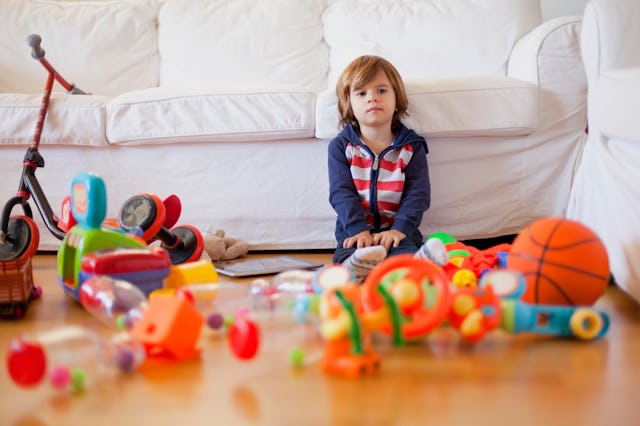Why Do Children Lose Interest In Toys So Quickly? It’s Complicated, Say Psychologists
They go from “gotta have it” to “I’m bored” in record time.

The speed at which kids get bored with toys can be baffling and frustrating for parents. We've all been there: A kid begs for a new toy and promises to love it forever, so you give in and buy it. The kid is over the moon and in love with their new toy, but a mere few days later, that toy is old news — and we're left scratching our heads.
To get to the bottom of this phenomenon, Scary Mommy tapped a few experts to discuss why kids do this and some possible solutions for combatting it.
What’s with the fleeting appeal of tempting new toys or gadgets?
Dr. Camille Ace, a licensed clinical psychologist (and mom of two), attributes this rapid loss of interest to some psychological and physiological principles. "A child's desire for the toy may be influenced by underdeveloped emotional regulation, poor impulse control, or peer pressure," she states. She explains that the underdeveloped decision-making process in children and teens may be a factor in boredom with a new toy because it's difficult for them to foresee the future outcome of losing interest when their emotional, irrational thoughts take over and decide they "need" the new toy.
"It could also be that the new toy, which initially seemed like a bright, shiny miracle, is, in fact, a toy that limits or does not ignite the child's imagination. A toy that limits a child's creativity can cause a loss of interest no matter how excited the child was initially to get their little fingers on the newest, hottest toy," she says.
Licensed clinical psychologist Dr. Rebecca Harvey, a mom of one, tells Scary Mommy another reason for the boredom might be that children have a natural limit to their attention span — generally speaking, this is about two to three times their age, so a 4-year-old would have about eight to 12 minutes of focus at a time.
Ace explains that clever marketing or social influence may also factor into their desire for a shiny new toy. "Children are easily and heavily influenced by the ads they see on TV or on YouTube. There's a reason commercials work; they hype toys up and make them look like endless fun. It's easy to understand why a child 'NEEDS' the new toy, especially if all their friends have one. We, as parents, hate the idea of our child feeling left out, so a quick fix is to simply buy them the new, popular novelty. But lo and behold, the new plaything isn't all it's cracked up to be," she says.
What's a parent to do?
Ace suggests that reducing the number of toys that the child has access to can help with level of interest. "As contradictory as it may sound, a child's interest thrives when they have fewer toys in front of them. Too many toys can cause a child to be overwhelmed because it's just too much for their minds to process. As parents, we often misunderstand their loss of interest and may purchase more toys we hope will retain their interest, but the cycle continues," she says.
Rotating the toys to "refresh" interest may also help because with kids, out of sight, out of mind is typically the case, says Harvey. Try putting some toys away for a while, and then when you get them back out, your child will be happy to see them because they will be a novelty. Then when they start to seem bored with them again, remove them from the play space and get some "new" ones out that they haven't seen in a while.
What should you consider when buying a new toy in the future?
Children typically lack the ability to weigh the costs and benefits, so they need our guidance to decide if the new toy is worth it or not.
Ace cautions against making an impulse buy swayed by you or your child's emotions. "The New Toy Decision can be based on so many factors: the child's emotional state, the parents' ability to navigate the child's emotional state, the outcome and balance of purchasing versus not purchasing the new toy (cost of toy, tantrums, guilt), and our memory (accurate or inaccurate) of the child's interest in prior 'new toys.’ As parents, we often see a new toy purchase as an opportunity to 'connect' with the child and ignore the obvious signs that the new toy may not be all it's cracked up to be," she says.
"The purpose of toys is for brain, motor skill, and social/emotional development. Having toys that hit on the key areas of development and stimulation (educational, pretend, action, and rolling push toys) is important," Harvey states. Before purchasing a new toy, she suggests exploring how the toy will be used. Some questions to ask yourself are: Will it enhance and challenge a child's imagination? Can the toy be used in multiple play activities, or is it a "limited play" toy? Am I just giving in to pacify them in this moment?
Harvey also reminds us that not all toys have to be fancy or cost a lot of money. "It's key to encourage creative and open play by having non-electronic/battery-operated toys and allowing children to 'create' toys and activities with household items like homemade goo or building a spaceship out of shipping boxes," she says.
This article was originally published on